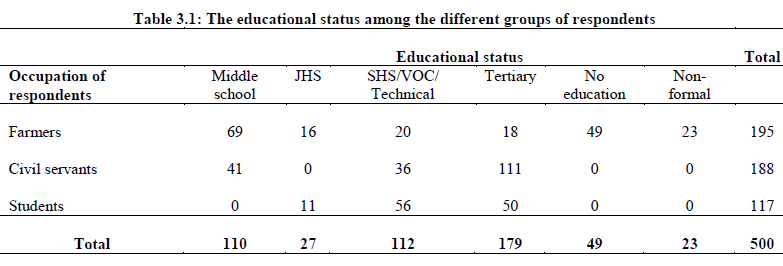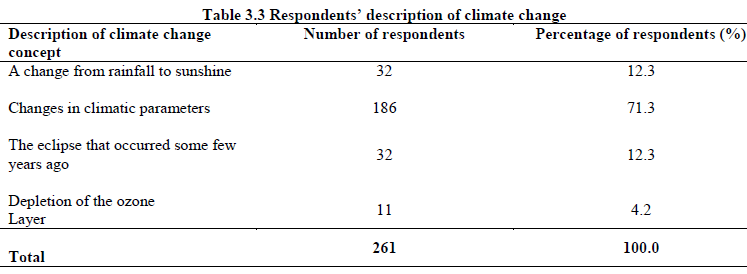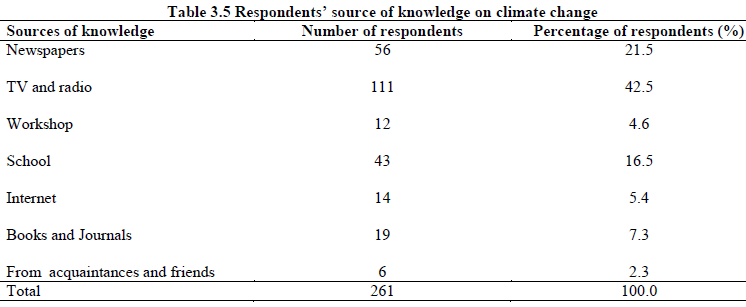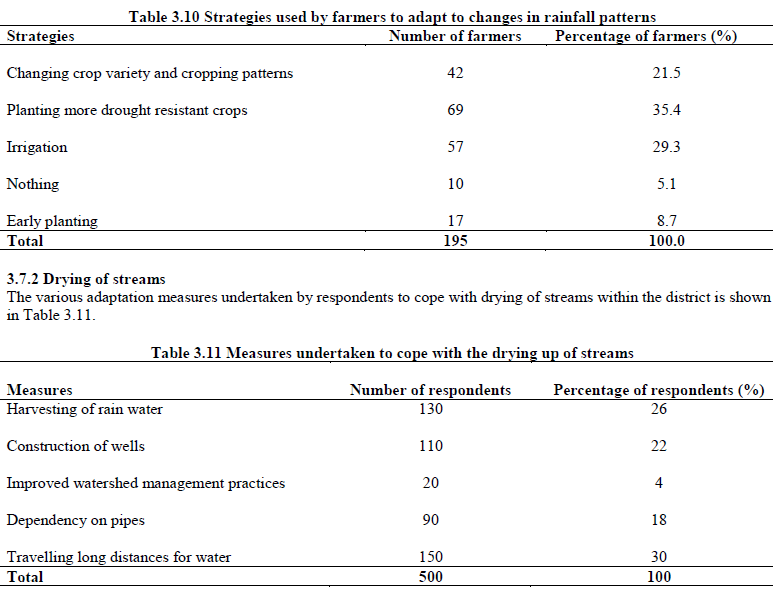ISSN ONLINE(2319-8753)PRINT(2347-6710)
ISSN ONLINE(2319-8753)PRINT(2347-6710)
Prince Twum Barimah1, Samuel Osei Kwadwo2, Oppong David3
|
| Related article at Pubmed, Scholar Google |
Visit for more related articles at International Journal of Innovative Research in Science, Engineering and Technology
Climate change is an issue that has received significant international attention over the past years. According to projections, it has potentially profound implications for future communities especially thosein developing countries. Since the knowledge and perceptions of people on climate change can affect the success of implemented adaptation and mitigation options, it is vital for societies to undertake regular assessments to gather this information.The study was conducted in Asunafo North District of Ghana. The study sought to determine the knowledge level of climate change among respondents, their perceptions on the impacts of climate change and measures they are undertakingto cope with its effects.Data was collected through administration of questionnaires, interviews and desk study. The sample size was (500) respondents categorized into farmers, civil servants and students. Knowledge was assessed by the ability of the respondents’ to describe the climate change concept if they have heard of it. The study indicated that the knowledge level was low (37.20%). However, knowledge varied among the targeted groups and was highest (61.30%) among the civil servants.In spite of the low level of knowledge on climate change among respondents, (70.00%) of them had detected changes in temperatures and rainfall regimes within the district over the years. Most (94.40%) of the farmers attributed these changes to the decline of crop yields in the area. As a result, various adaptation measures such as the planting of more drought resistant crops and changes in crop varieties have been employed to cope with the changes.There is the need for the mass media in Ghana to be actively engaged in the communication of climate change since it was identified as the primary source of information for respondents.
Keywords |
| climate change, perception, questionnaire, adaptation, mitigation, respondents |
INTRODUCTION |
| Climate change is one of the greatest challenges currently facing human and the environment [1]. Evidence shows that many biological systems are being affected by climate change through increasing temperatures and changes in rainfall regimes [2]. Many projections indicate the impact will worsen if effective measures are not taken immediately to solve the problem [1]. As a result, there has been a significant international attention over the last few decades to control the situation. Many adaptation and mitigation measures have been proposed [3].These measures will be effective if they are based on the perceptions of all groups in the society[4].Thus, it is essential to assemble the opinions of the public especially rural communities in formulating effective climate change policies since public perceptions will likely influence the success of strategies to solve the problem [4, 5, 6]. Due to their dependence on rain-fed agriculture and lack of institutional and financial capacities, such communitiesare more vulnerable to climate change [7, 8] |
| However, in Ghana, there is lack of documentation onthe knowledge and perception of such communities on climate change. As a result, effective adaptation and mitigation policies are difficult to be formulated by relevant authorities [9]. This study therefore seeks to fill thisvoid. The study was undertaken within the Asunafo North District of Brong Ahafo region in Ghana.The objectives of the research were todetermine the level of knowledgeon climate change in the Asunafo North District, identify their perceptions on the impacts of climate change on their livelihoods and to determine the efforts being made by them to adapt to the effects of climate change. |
MATERIALS AND METHODS |
Study Area |
| The Asunafo North district is within the Brong Ahafo region of Ghana.Goaso is the district capital and the largest within the district. It lies between latitudes 6°27’N and 7°00’N and longitudes 2°52’W. The total land size of the district is 1093.7km2 with 389.7 km2 covered by forest reserves [10]. The district experiences the wet-semi-equatorial climate. Temperature is uniformly high all year round with March as the hottest month. The mean monthly temperature is about 25.50C.The district experiences a double maxima rainfall pattern with the mean annual rainfall roughly between 125cm and 175cm. The major rains occur between April and July with the minor falling between September and October. There is a short dry spell in mid-August before the prolonged dry season between November and March. The main planting season starts with the onset of the major rains [10]. |
Data Collection |
| Two towns within the district were purposively selected for data collection. These were Goaso, the district capital and Mim, a key commercial town. 250 respondents were drawn from each town making a sample size of 500. The target groups used for the survey were farmers, students and civil servants.Data was collected through administration of questionnaires, interviews and desk study. Desk study was used to gather information about the study area. The information relating to climate, location and size of the area were collected from the appropriate institutions. These institutions included the District Meteorological Service and the District Assembly. Both close-ended and open-ended questions were used to determine the respondent’s perceptions on climate change. Some aspects of the questionnaire had to be explained to the respondents before they were able to give appropriate responses. Although all the questions were set in English, the local language (Twi) was also use as a communication medium during data collection especially with the farmers. |
Data Analysis |
| Data collected was analyzed using the Statistical Package for Social Sciences (SPSS). |
RESULTS |
Characteristics of respondents |
| Out of the 500 respondents interviewed, males represented 52% and females made up 48%. Farmers were the most dominant group representing (39%) of the respondents followed by civil servants (37.6%) and students (23.4%). The educational status among the different groups of respondents is shown in Table 3.1. 62% of the respondents with tertiary educationbackground were civil servantswhilst 62.7% of those with middle school status were farmers. |
 |
Knowledge of climate change |
| To help in the assessment of knowledge on climate change, respondents were first asked if they have heard of the concept. 52.2% of the respondents replied yes whilst 47.8% indicated no (Table 3.2). |
 |
Description of climate change by respondents |
| The (261) people who indicated that they have heard of the climate change concept were further asked to describe what they heard about it. 71.3% indicated that the concept has to do with changes in climatic parameters, 12.3% of the respondents attributed the concept to the eclipse that occurred some years ago whilst only 4.2% attributed the concept to the depletion of the ozone layer (Table 3.3). |
 |
| Description of the climate change concept by the various groups of respondents is depicted in Table 3.4.Out of the 261 respondents who were able to give accurate description, 60.9% were civil servants, 19.1% were farmers and 20% were students. |
 |
 |
Source of knowledge on climate change |
| The respondents were also asked to provide the source where they obtained their knowledge about the concept. The major source of knowledge among the various respondents was Television and radio followed by newspapers. 42.5% of the 261 respondents who said that they have heard of climate change indicated that they obtained their knowledge from television and radio with 21.5% obtaining their knowledge from various newspapers (Table 3.5). |
 |
| Out of the 56 respondents who cited newspapers as their source, 70.4% were civil servants and 17.3% were students. TV and radio stations were the primary sources for most of the farmers. |
Causes of climate change |
| Respondents were asked if they personally believe climate within the district has changed. This question was put to all respondents irrespective of their knowledge on climate change. 350 of them believed that climate within the district has changed over the years. Out of this number, 250 representing about 71% attributed the cause to natural process (Table 3.6). |
 |
Perceptions on impacts of climate change |
| Questions asked in this section were intended to determine whether the respondents have observed any change in rainfall pattern and amount and the effects of these on food production. The questions were also to determine any change in atmospheric temperature and its effects |
Perceptions on changes in rainfall pattern and amount |
| Out of the 350 respondents who believed there have been changes in rainfall pattern and amount, 42.9% indicated that rainfall pattern has become erratic in the last few years, 51.4% indicated that rainfall amount has being decreasing whilst only 5.7% indicated that rainfall amount have rather increased (Table 3.7). |
 |
Perception of impacts on food production |
| The farmers were asked if crop yields have been affected by the changes in rainfall patterns and amounts. 94.4% of the 195 farmers replied yes (Table 3.8). They were specifically asked this question because food production within the Asunafo North district is dependent on availability of rainfall. |
 |
Perceptions on changes in atmospheric temperatures |
| Out of the 350 respondents who indicated a change in climate within the district, 98.6% believedthat atmospheric temperatures have increased over the last few years (Table 3.9). |
 |
Perceptions of impact on water resources |
| Respondents were asked to provide their opinions on whether changes in rainfall regimes and increasing temperatures have had any effect on water bodies especially streams within their communities. It was revealed that (90%) of the respondents were aware that many streams have dried up over the years. Although activities of human along river banks were cited as a reason for the dried up streams, increasing temperatures and rainfall patterns were cited as the primary causes. |
Adaptation measures for coping with climate change |
Changes in rainfall regimes |
| Most of the measures employed by farmers to cope with the changes in rainfall patterns and amount were planting more drought resistant crops and engaging in irrigation practices as depicted in Table 3.10. |
 |
DISCUSSION |
Knowledge of climate change |
| Knowledge of climate change was assessed by the ability of respondents to accurately describe the concept if they have heard of it. From Tables 3.2 & 3.3, knowledge amongst the respondents was low (37.2%).Out of 500 respondents, only 186 were able to give the scientific explanation of climate change. This low level of knowledgeon climate change is consistent with many other climate change perception studies undertaken in Africa [11]. The primary reason is the lack of media reportage and discussion on the concept. Since the mass media largely serve as source of information to the public, the low level of discussion in the media directly limits the amount of information relayed to the public [1]. Amongst the different occupational groupings, knowledge level was highest among the civil servants. Out of the 186 respondents who were adjudged to have knowledge about climate change; about 61% were civil servants. In Ghana, these are the people who normally tune into foreign media outlets such as Cable News Network (CNN) and British Broadcasting Corporation (BBC) and thus likely to hear of climate change from such broadcasters. Out of 350 respondents who personally believed that climate within the district has changed over the years;about 71% attributed the cause to natural process. As a highly religious country, many Ghanaians have beliefs that God is the ultimate cause of changes in weather process. This belief is common in many African communities [11]. |
Perceptions on impacts of climate change |
Impact on food production |
| Almost all farming activities within the district depend on rainfall. As a result, most of the farmers were emphatic in their assessment of the effects of the changes in rainfall pattern and amount on crop production. According to them, crop yields have been reducing as a result of these changes. This finding is consistent with the Fourth Assessment Report of the Intergovernmental Panel on Climate Change(1PCC) which identified reduction in agricultural productivity and yields due to climate change in some regions of the world [2]. Other studies by [7, 8] also made similar findings. |
Impact on water resources |
| The effect of the drying up of streams on people was well noticed by the respondents due the close linkage of the streams and some aspects of their livelihoods. The streams serve as drinking water to some of the communities within the district. Although streams usually dry up in the dry season, over the last few years, the situation according to respondents has worsened with some streams even drying up in the rainy season. This finding is backed up by many studies [11, 12] which cited climate change as the cause of drying up of rivers and streams in many parts in Africa. |
Assessment of adaptation measures to cope with climate change |
| According to Maddison [13], adaptation to climate change actually involves a two-stage process: first perceiving that climate change has occurred and then deciding whether or not to adopt a particular measure. Due to the impacts of increasing atmospheric temperatures and changes in rainfall patterns on the livesof respondents, various adaptation measures have been implemented. Even those who were not aware of “climate change” have implemented some measures. |
Changes in rainfall pattern and amount |
| Table 3.10 shows adaptation measures initiated by farmers due to changes in rainfall regimes within the district. The main measures implemented by the farmers were changing crop varieties and patterns and planting more drought resistant crops. Almost 57% of the 195 farmers used for the study had undertaken such measures Theseadaptation measures support a study conducted by the Centre for Environmental Economics and Policy in Africa (CEEPA, 1986) across Africa which asserts that for changes in rainfall patterns, farmers make changes in crop varieties andvary planting dates [13]. |
Impact on water resources |
| Although pipe-borne water and boreholes are available within some sections of Goaso and Mim, streams also serve as drinking water for some of the inhabitants. The streams are also used for washing clothes and bathing. As a result, all the respondents had taken measures to cope with their drying up. The main measures were harvesting of rain water, travelling of long distances to fetch water in nearby communities and construction of small wells in their households. |
CONCLUSION |
| This study sought to find out the level of awareness of climate change in the Asunafo North District, how the respondents express their perceptions on climate change and how they are adapting to the effects of climate change.The level of awareness was adjudged to be low.The reason was the lack of many mass media discussion on climate change in Ghana. However, awareness varied among the three occupational groupings targeted and was highest among the civil servants.Although their knowledge level on climate change was low, most of the respondents were aware of changing trends in atmospheric temperatures and rainfall patterns. Also, they were aware of the effects of these changes on crop production and water bodies within the district. As a result,most of the respondents have initiated various adaptation measures. These measures ranged from construction of wells around houses and the harvesting of rain water to cope with the drying of water sources such as rivers and streams.Among the farmers, efforts to lessen the burden on crop production from changes in rainfall regimes included changing crop patterns and planting more drought tolerant species. |
| From the study, the following are recommended: |
| 1. The mass media must be actively engaged in the communication of climate change |
| 2. The government must continuously engage local communities in the formulation of climate change policies |
References |
|